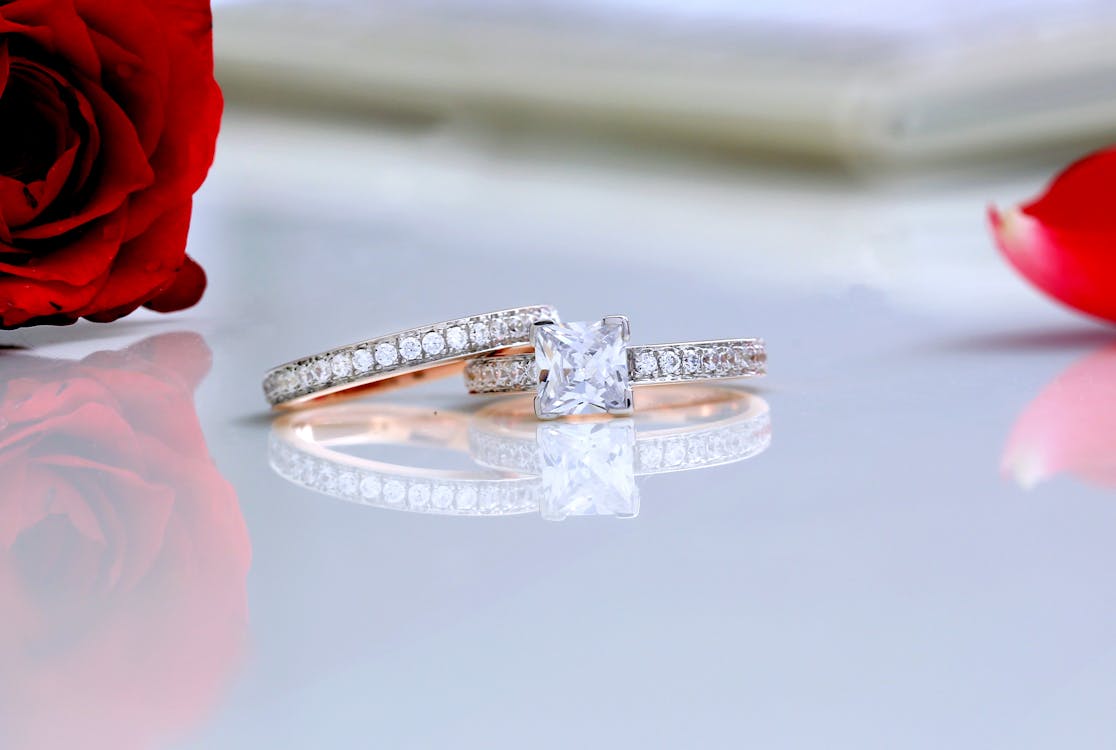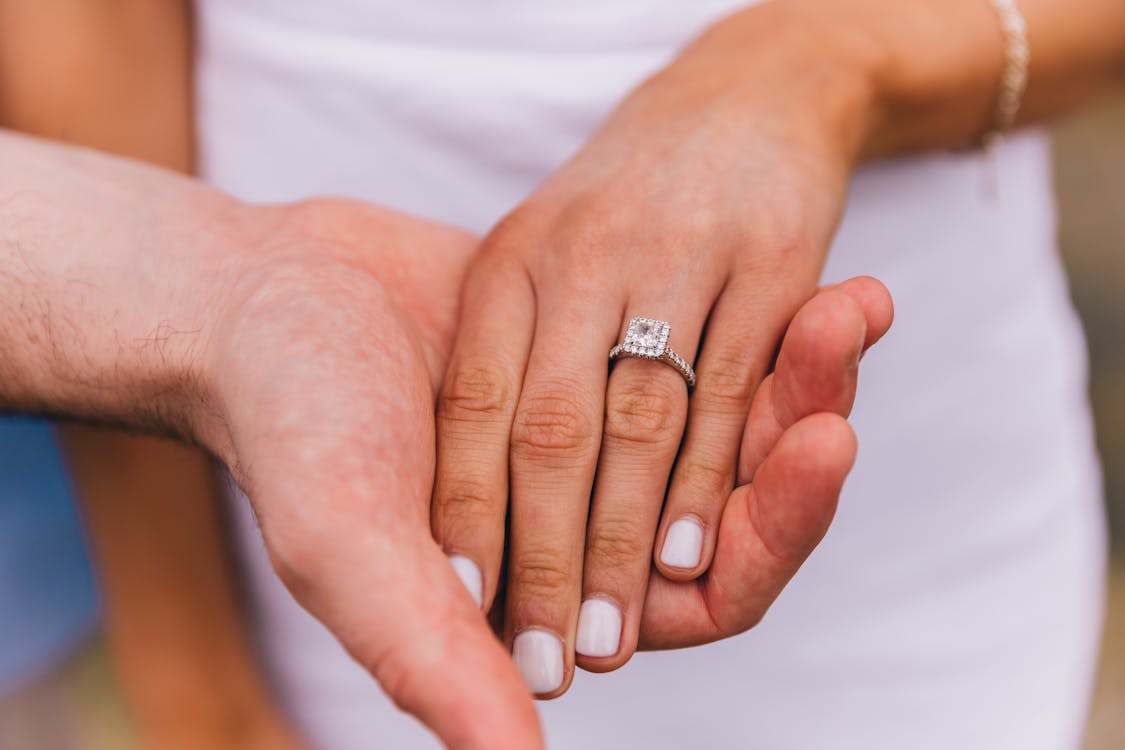Guide To Princess Cut Diamonds
Most people probably aren’t aware of just how many shapes of diamonds there are. Round-cut diamonds are the most popular diamond shape and are so popular that it is the most obvious in most people’s minds. It isn’t until you think about buying a loose diamond or a piece of diamond jewelry and start browsing the jewelry shelves you realize there is quite a variety of shapes.
But, not only are you faced with different shapes, but you’ll also find that the term cut comes into the equation. Are cut and shape the same thing? It helps to know.
The Difference Between Cut and Shape
Although commonly used interchangeably, the two words have different meanings in defining a diamond (or any other GIA or AGS-certified gemstone).
A diamond’s shape is created by the cutting of the rough stone. The cut is one of the 4Cs grading system for diamonds and refers to facets and angles the diamond cutter creates to make the most of the stone’s overall beauty and dazzle.

The shape refers to the geometry of a diamond. You can get pure geometrical shapes like round brilliant cut, square cut, baguette cut, and emerald cut but there are also fancy shapes like Asscher cut, radiant cut, and princess cut.
The type of jewelry you are looking for will be a factor in your choice of diamond shape. For example, not all fancy-cut diamonds are suitable as a center stone of a solitaire engagement ring. Round brilliant cut diamonds obviously are as are princess diamonds.
Here is our guide to princess-cut diamonds.
What Is A Princess Cut Diamond?
A princess-cut diamond is a type of square diamond with excellent levels of brilliance and fire. It is a fancy shape diamond that begins life as a rough diamond in the form of an inverted pyramid. It is widely acknowledged that princess cuts are among the most brilliant of all the various diamond shapes, making them a popular choice for modern engagement rings and diamond stud earrings.

Developed in the 1960s, the princess is the second most popular diamond shape. It is a square to slightly rectangular shape created by brilliant style cutting rather than traditional step cutting. This creates extra facets to deliver greater brilliance and scintillation. It is technically known as a “square modified brilliant” and is a good cut to hide inclusions although it can make the stone’s color less noticeable when viewed face up.
The most coveted princess-cut diamonds are those with a distinct square shape and a length-to-width ratio of 1.00 to 1.05. Though you can sometimes find rectangular princess-cut stones, they are not as desirable as their square counterparts because they lack a degree of brilliance. Any princess cut stone with an Excellent or Ideal cut quality will make a stunning engagement ring.
The key features of a quality princess-cut diamond include:
- A square shape to provide the best possible brilliance.
- Two to four signature chevron patterns.
- A lower price tag per carat than a round-cut diamond, due to the fact that more of the rough stone is preserved during the cutting process.
Length To Width Ratio
Traditionally, the princess diamond is a square cut stone that is made with four equal sides. As mentioned above the ideal length-to-width ratio (sometimes referred to simply as W ratio) is 1.00 to 1.05, but if you are looking for what is considered the most desirable for a princess cut diamond, then consider the tighter ratio of 1.00 to 1.02. i.e. the closer to a perfect, absolutely symmetrical square, the better.
How Much Does A Princess Cut Diamond Cost?
Due to the higher yield from the cutting process, princess-cut diamonds tend to be between 25% and 35% cheaper than round-cut diamonds. Less is lost from the original stone after cutting and polishing.
Of all the various fancy shape stones, princess cuts are the most affordable per carat weight so are the best if you are looking to maximize your budget. Purchase a princess diamond engagement ring and you will get that amazing diamond sparkle, fluorescence, and fire without having to pay as much as for a brilliant round cut.
Color Grade
On a value-per-carat basis, the princess cut is always a good choice because it balances out extreme beauty with a more comfortable cost. Not only does the cut achieve brilliance and fire but you can also slightly go a little down the scale for clarity and color - again getting value for money.
A high-quality princess cut can mask a few inclusions and slightly downplay body color but they will be invisible to the naked eye. Choosing lower color and clarity grades is going to reduce the cost of the stone.
If you are looking to get a cool and icy white appearance in your diamond, something that looks fabulous in a ring setting of white gold, then you should aim for a G rating or higher. If, however, you want your princess-cut diamond ring to be yellow gold or rose gold, then you can certainly get away with choosing a warmer-looking diamond. A J or K color grade diamond will enhance the tones of the gold.
Clarity Grade
Well-cut princess diamonds always display a good level of scintillation and brilliance that can do wonders to help mask small flaws in the stone. If you don’t want to pay for a truly premium high-clarity grade that doesn’t have any visual benefits to the naked eye, then a princess-cut diamond is a perfect choice.
If you are looking to hit that sweet spot of quality diamond and good price, then opt for stones in the clarity range of SI1 and VS2 as long as the diamond appears to be ‘eye clean’ which means that the inclusions can’t be seen with the naked eye even if they are technically present and their light performance isn’t affected.
The thing to take note of when purchasing a princess cut diamond that might be on the ‘lower’ end of the clarity scale is that you should always buy from a jeweler that can provide enough photos and videos of the stone for you to be able to assess the eye cleanliness thoroughly for yourself.
The various gradings we’ve mentioned will be detailed on the grading report issued by the Gemological Institute of America and are an important part of the diamond buying process,
The 4 Pointed Corners Are Vulnerable Areas
One of the things that customers need to pay attention to when purchasing a princess-cut diamond is the vulnerability of the four sharp corners. The nature of the cut is that these corners (also known as culets) can be prone to chipping due to the lower mechanical strength of these particular points.
If you can afford to, the advice is to avoid princess cut diamonds that have severe inclusions near the corner points, because that is a sign of a weak crystalline structure which will lead to durability issues over time when you factor in the strain of the prongs and bezel in something like a princess cut engagement ring.
Beware of Weight Retention Tricks
Unfortunately, not every single person involved in the diamond-selling business is honest and reliable, and in a profit-driven environment, the truth is that a lot of polished stones are cut in a way to preserve the maximum weight of the rough. This will usually be done at the expense of the cut quality and therefore the sparkle.
With princess cut diamonds, the signature indicators that there has been some trick with weight retention techniques is a table percentage of 80% or higher, along with very thick to extremely thick girdles.
The main thing to remember is that higher carat weight does not always equal better quality.
The “Ideal Princess”
Getting the best diamond for your money often involves some trading-off between the 4Cs. Being eye-clean means you might make a small compromise in clarity and if a stone is near-colorless, it is a small concession that results in a lower price.
If you want maximum fire and brilliance and the largest possible size for your budget, choose an 0-certified princess cut. This is described as an ideal princess diamond. Diamonds of this nature are only certified by American Gemological Society (AGS) laboratories. the GIA does not grade on the light performance of a stone.
If you can find an 0-certified princess cut, you can be assured of a diamond with sparkle and fire unmatched by ordinary princess cuts.




